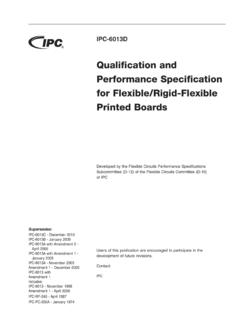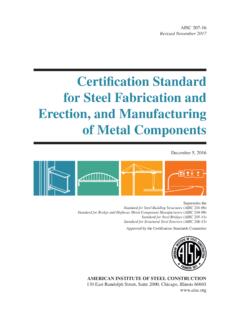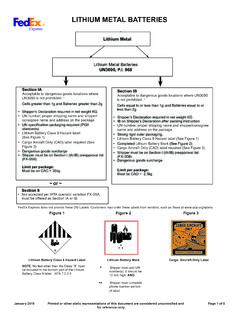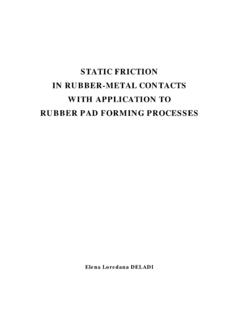Transcription of NZ METAL ROOF AND WALL CLADDING CODE OF PRACTICE
1 CODE OF PRACTICENZ METAL ROOF AND WALL CLADDINGVERSION / 2012NZ METAL ROOF AND WALL CLADDING CODE OF PRACTICE NEW ZEALAND METAL ROOFING MANUFACTURERS INC. APRIL 2012 PREFACEThis NZ METAL Roof and Wall CLADDING Code of PRACTICE is published by the NZ METAL Roofing Manufacturers Inc., to provide prescriptive acceptable trade PRACTICE for the fixing of METAL roof and wall CLADDING and accessories. In addition it provides prescriptive detailing for designers and sets a benchmark for the standard of detailing and workmanship required over and above that required deemed to comply with the NZBC.
2 This does not pre-empt or preclude the use of alternative methods that would also require specific acceptance by the Building Consent Authorities. This Industry Code of PRACTICE is published as the current state of the art at publication date, however it is recognised that as building is a dynamic industry the Code is a living document, and that alterations to legislation, standards, improved technology and new materials will require periodic upgrading of this Code of of the NZMRM Code of PRACTICE as published at November 2012 supersedes the original versions published in 2008 and of Version 2 are now available as Version in a pdf format which can be downloaded from the MRM website.
3 Version is also available to be used on the website with options to print, email and search topics. The illustrations in the Code of PRACTICE can be downloaded from the website as eps. or jpeg files. The Code of PRACTICE is protected by copyright however the drawings and text are available to be copied and printed provided a signed license agreement is completed with the NZMRM and acknowledgment is pdf and website documents of the Code of PRACTICE Version are structured to mirror each other page for page so that any reference from one document can quickly be identified in the other by page number or section number.
4 A red line and date has been included to indicate where Version 2 has been updated to Version References to consult or refer to the Manufacturer or in accordance with standard trade PRACTICE have been omitted. This Code of PRACTICE has been prepared after general consensus has been obtained between suppliers, manufacturers, and members of the Roofing Association of New Zealand (RANZ).The Code is divided into three parts:1. The performance requirements, and the prescriptive means to comply with this Code of PRACTICE are printed in black bold font and blue shaded.
5 They are summarised in Section 17 the Appendix. The What and the How . The first part is normative, compliance is mandatory to comply with this Code of PRACTICE and the word must is used. 2. The recommended better PRACTICE options and the responsibilities of different parties to comply are printed in black - the Should know and should do s . The second part is not mandatory but describes better options or alternatives. They are described by the words should , recommend , preferred and may . 3. The reasoning used to formulate the above is printed in blue - the Why.
6 The third part is informative, it is for information and provision of the third part is intended to provide the education necessary to inform designers, to complement and complete the training required to qualify as a Licenced Building Practitioner or skilled tradesperson and also to be used as a text book in such training. The Code of PRACTICE is intended to be a stand-alone document, however users are urged to read manufacturers literature and other relevant documentation that should be used in conjunction with this Code of PRACTICE .
7 Although it is written in user friendly terminology some words may not be in common usage however definitions and alternative words are found in section NZ METAL ROOF AND WALL CLADDING CODE OF PRACTICE NEW ZEALAND METAL ROOFING MANUFACTURERS INC. APRIL 2012 are urged to read the complete document, as the reasoning and commentary provide a means of compliance with details and situations that may have not been previously encountered. Because METAL roof and wall CLADDING is now regarded as a system and not a product, the interaction with, and the dependence on, other materials requires an understanding of the total Building Envelope.
8 The implications of some subjects, such as condensation and loadings, are not always understood by designers, and therefore the roofing contractor has a responsibility to draw attention to any inadequate or incorrect detailing. No apology is offered for the complexity or any repetition included in this Code of PRACTICE . Cross- referencing has been necessary to avoid duplication, but is available electronically by hyperlink throughout the Code, via the contents, the description, drawing details or find or search .Specifiers, manufacturers, tradespeople and the public should be aware of the limitations of the material they are using, because without full understanding users can be held liable for lack of duty of care.
9 This document should be regarded as the state of the art at the time of publication, however it is incumbent on all practitioners to ensure that any documentation used is the current version published by the NZMRM Code of PRACTICE has been written to assist in meeting the requirements of the NZBC. partly because of the many conflicting and overlapping Standards used within the Building Industry. A current NZ, joint NZS/AS Standard or a Producer Statement can be cited as a means of specific compliance acceptable to a Building Consent Authority but which does not coincide with this Code of PRACTICE .
10 The information and evidence offered in support of the requirements of this Code has been obtained after wide consultation with associated industry participants resulting in a general consensus, acceptance and approval of those New Zealand Roof and Wall CLADDING Code of PRACTICE has been written for New Zealand conditions that recognize it as an unique island 2,000 km away from another major land mass, which is subject to high rainfall, high humidity, extremes of weather and high winds. The contents of this Code of PRACTICE are relevant to other countries, but the information contained in this document should be moderated appropriately in accordance with local conditions.










